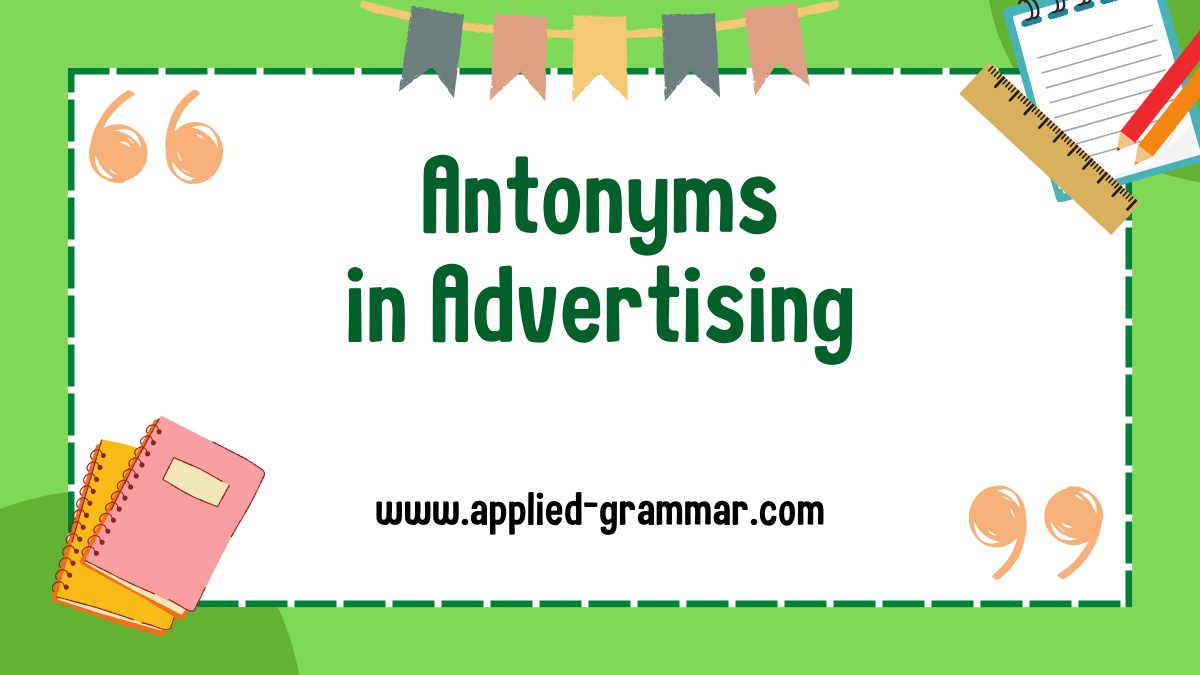Are you looking to make your advertising more persuasive and captivating? One powerful technique to consider is the use of antonyms. Antonyms are words that have opposite meanings, and when used strategically in advertising, they create a strong contrast that grabs the attention of your audience.
In the world of advertising, it’s all about standing out and making an impact. By incorporating antonyms in your marketing messages, you can create a sense of tension and intrigue that draws people in. Think about it – when you see an ad that presents two contrasting ideas or qualities, it immediately catches your attention and makes you want to learn more.
In this article, we will explore how antonyms can be used effectively in advertising to persuade and engage your target audience. We’ll discuss the power of contrast, the importance of parallel structure, and provide real-life examples of successful antonym-based ads. So, if you’re ready to take your advertising to the next level, let’s dive in and discover the art of persuasion through contrast.
The Power of Antonyms in Advertising

Using Contrast to Grab Attention
In the world of advertising, capturing and holding the attention of the audience is essential. One effective technique that advertisers use is the strategic use of antonyms – words with opposite meanings. By incorporating antonyms into their marketing messages, advertisers create a strong contrast that immediately grabs the attention of the audience.
The power of contrast lies in its ability to create tension and intrigue. When two opposing ideas are presented side by side, it creates a sense of curiosity and captivates the audience. This contrast serves as a hook, drawing people in and making them want to learn more.
For example, a skincare ad might use the antonyms “before” and “after” to showcase the transformative effects of their product. The stark contrast between a dull, tired-looking face and a glowing, rejuvenated complexion instantly captures the viewer’s attention and sparks their interest.
Creating Emotional Impact
Antonyms also have the ability to evoke strong emotions in the audience. By presenting contrasting ideas, advertisers can tap into the emotions of the viewers and create a deeper connection with their brand or product.
For instance, a car commercial might use the antonyms “freedom” and “confinement” to convey a powerful emotional message. The contrast between the open road and the feeling of being trapped in a mundane routine creates a sense of longing for freedom and adventure. This emotional impact resonates with the viewers and makes the advertisement more memorable.
When used strategically, antonyms can enhance the persuasive power of advertising by creating attention-grabbing contrasts and evoking strong emotions in the audience. By harnessing the power of antonyms, advertisers can take their marketing messages to the next level and leave a lasting impression.
Types of Antonyms in Advertising

Opposing Descriptors
In advertising, one common way to utilize antonyms is by using opposing descriptors. This technique involves highlighting the stark contrast between two opposite qualities or characteristics of a product or service. By juxtaposing these opposing descriptors, advertisers create a powerful effect that immediately captures the attention of the audience.
For example, a skincare brand might use antonyms like “aging” and “youthful” to promote their anti-aging cream. By emphasizing the difference between aging skin and youthful, rejuvenated skin, the advertisers create a sense of urgency and desire in the viewer. This technique is effective because it taps into the audience’s desire to look and feel younger, and positions the product as the solution to their aging concerns.
Contrasting Imagery
Another way to incorporate antonyms in advertising is through contrasting imagery. Advertisers can use visuals that depict opposing elements or scenarios to create a strong impact on the audience. This technique works by stimulating the viewer’s senses and evoking strong emotions.
For example, a car commercial might show the contrast between a congested city street and an open highway, highlighting the freedom and excitement of driving their car. By contrasting the two images, advertisers can convey a powerful message about the benefits of their product.
Antonyms in advertising are a powerful tool to grab attention and evoke emotions. Whether it’s through opposing descriptors or contrasting imagery, incorporating antonyms can enhance the persuasive power of advertising and leave a lasting impression on the audience.
Examples of Antonyms in Advertising

Slogans and Taglines
In the world of advertising, slogans and taglines play a crucial role in capturing the attention of the audience and conveying the message of a brand or product. Antonyms are often utilized in these short and catchy phrases to create a powerful impact. By juxtaposing contrasting words, advertisers can highlight the unique selling points of their product or service. Here are a few examples of antonyms commonly used in slogans and taglines:
- “Taste the Rainbow” (Skittles) – This slogan employs the antonym of “taste” and “rainbow” to emphasize the vibrant and diverse flavors of Skittles candies.
- “Think Different” (Apple) – Apple’s iconic tagline challenges the status quo by contrasting the idea of embracing individuality and innovation with the mundane notion of conformity.
- “Impossible is Nothing” (Adidas) – This tagline effectively communicates the brand’s commitment to pushing boundaries and defying limitations.
Print Ads
Print advertisements provide a visual medium for advertisers to creatively incorporate antonyms and convey their message to the target audience. Through the use of contrasting imagery or opposing descriptors, print ads can evoke strong emotions and leave a lasting impression. Here are a couple of examples of how antonyms are used in print ads:
- An automobile advertisement showcasing a luxurious car juxtaposed with a dilapidated vehicle to highlight the stark difference in quality and performance.
- A beauty product advertisement featuring before and after images to demonstrate the transformative power of the product, emphasizing the contrast between the individual’s starting appearance and the desired outcome.
TV Commercials
TV commercials offer a dynamic platform where advertisers can effectively utilize antonyms to captivate viewers and communicate their brand’s message within a short span of time. By presenting opposing scenarios or contrasting imagery, TV commercials can create a sense of urgency, desire, and even humor. Here are a few examples of how antonyms are employed in TV commercials:
- A fast food commercial showcasing the contrast between a dull and unappetizing homemade meal and a vibrant, mouthwatering feast from the brand, enticing viewers with the promise of indulgence and enjoyment.
- A cleaning product commercial highlighting the drastic difference between a messy and chaotic living space and a sparkling, pristine home after using the product, emphasizing the convenience and effectiveness of the brand.
By incorporating antonyms in advertising strategies, brands can enhance their persuasive power and leave a lasting impression on their audience. Through slogans, print ads, and TV commercials, these contrasting elements effectively convey the unique qualities and benefits of a product or service.
The Psychological Impact of Antonyms in Advertising

Cognitive Dissonance
Antonyms in advertising can create a powerful psychological impact on the audience by inducing cognitive dissonance. Cognitive dissonance is a psychological term that describes the discomfort people feel when they hold two conflicting beliefs or when their beliefs do not align with their actions. By using antonyms, advertisers can highlight the stark contrast between the current state of the audience and the desired state that the product or service promises to fulfill.
For example, consider the slogan “Go from ordinary to extraordinary.” This phrase creates cognitive dissonance by contrasting the current state of being ordinary with the desired state of being extraordinary. By evoking this discomfort, advertisers can motivate their audience to take action and seek the product or service that can bridge the gap between their current and desired states.
Appeal to Emotions
Antonyms are also effective in advertising because they have a strong emotional impact on the audience. Emotions play a significant role in shaping consumer behavior, and advertisers understand this. By using antonyms that evoke contrasting emotions, companies can create a memorable and impactful advertisement.
For instance, consider the tagline “Feel the thrill. Leave the fear behind.” This phrase utilizes antonyms to create a contrast between the exhilaration of experiencing something thrilling and the fear that holds people back. By highlighting this contrast, advertisers tap into the audience’s emotions, making them more likely to connect with and remember the advertisement.
Antonyms in advertising have a powerful psychological impact on the audience. They can induce cognitive dissonance, creating a sense of discomfort that motivates action, and appeal to emotions, evoking contrasting feelings that resonate with consumers. By leveraging the power of antonyms, advertisers can effectively persuade their audience and leave a lasting impression.
How to Effectively Use Antonyms in Advertising

Understanding Your Target Audience
To effectively use antonyms in advertising, it’s crucial to have a deep understanding of your target audience. Start by conducting thorough market research to identify their demographics, preferences, and pain points. By getting to know your audience, you can tailor your advertising message to resonate with them on a deep level. Understanding their desires, fears, and aspirations will help you identify the right antonyms to use in your ads.
Crafting the Message
Once you have a clear understanding of your target audience, it’s time to craft the message that will grab their attention. Begin by identifying the unique selling points of your product or service. What sets it apart from the competition? What benefits does it offer that are valuable to your audience?
Next, think about the emotions you want to evoke in your audience. Antonyms can be a powerful tool for creating contrast and stirring emotions. Consider the desired state your audience wants to achieve and the current state they are in. Use antonyms to highlight this difference and create cognitive dissonance.
For example, if you’re promoting a weight loss product, you could use antonyms like “before and after,” “fat and fit,” or “unhealthy and vibrant.” These pairs evoke strong emotions and make your audience yearn for the desired state represented by the antonym.
Choosing the Right Antonyms
Choosing the right antonyms is crucial to the success of your advertising campaign. Here are a few key considerations:
- Relevance: Ensure that the antonyms you choose are relevant to your product or service. They should highlight the unique features or benefits that make your offering stand out.
- Clarity: The antonyms you select should be easily understandable and recognizable by your audience. Avoid using obscure or complex pairs that may confuse or alienate them.
- Impact: Look for antonyms that have a strong emotional impact. Words that evoke contrasting emotions create a powerful connection with your audience.
- Resonance: Consider the cultural context and values of your target audience. Choose antonyms that resonate with their beliefs, aspirations, and desires.
By understanding your target audience, crafting a compelling message, and choosing the right antonyms, you can effectively use antonyms in advertising to grab the attention of your audience and persuade them to take action. The power of contrast and emotions can make a lasting impression and drive your audience to engage with your brand.
Conclusion
Antonyms in advertising are a powerful tool that can captivate and engage audiences. By using opposing descriptors and contrasting imagery, advertisers can create a strong impact and evoke emotions. Throughout this article, we explored how antonyms are used in slogans, taglines, print ads, and TV commercials to highlight the unique selling points of a product or service.
To effectively use antonyms in advertising, it is crucial to understand the target audience and tailor the message to resonate with them. By understanding their desires, fears, and aspirations, advertisers can create a connection and stir emotions. Antonyms can be used to create contrast, evoking a desired state and highlighting the difference between the current state and the desired state.
Choosing the right antonyms is also essential. They should be relevant, clear, impactful, and resonant. By following these strategies, advertisers can effectively grab the attention of the audience and persuade them to take action.
Antonyms in advertising provide a powerful means to communicate and persuade. By harnessing the power of contrast, advertisers can create memorable campaigns that resonate with their target audience and drive them to action.
